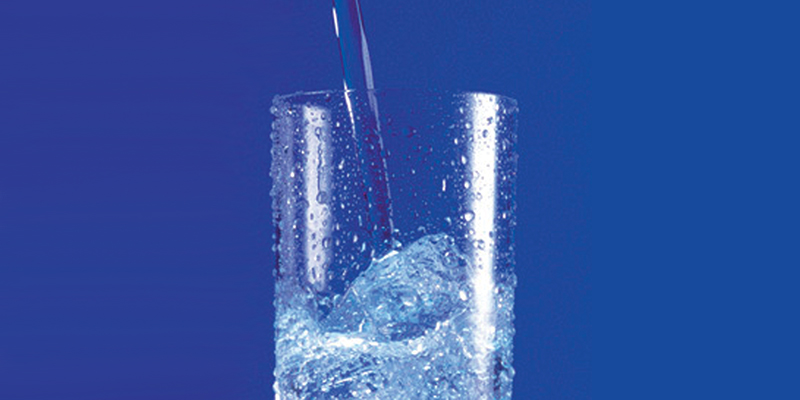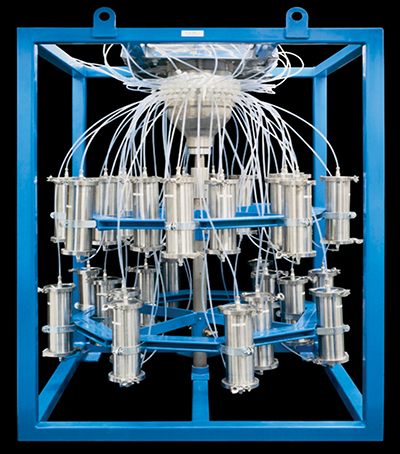
Pure Water From a Pure Genius
UMPQUA Research Company (URC), a veteran Small Business Innovation Research (SBIR) partner with NASA, has once again stepped up to the plate with a solution to protect one of the world's most precious natural resources: water. After helping to develop a baseline water purification system for the International Space Station and a microwave regenerable air purifier for Moon base and Mars missions, URC of Myrtle Creek, Oregon, has come back down to Earth with a process for destroying perchlorate and nitrate in water.
Ammonium perchlorate is widely used throughout the aerospace, munitions, and pyrotechnics industries as a primary ingredient in solid rocket and missile propellants, fireworks, and explosive charges. Following the Cold War, the U.S. Department of Defense was left with roughly 140 million pounds of ammonium perchlorate to dispose of between 1993 and 2005. This highly soluble salt has tainted soils and water sources all over the world, and is believed to be an endocrine disrupter, adversely affecting the growth patterns of a fetus or a young child, according to recent medical studies.
Perchlorate contamination was first discovered in northern California in 1997. Upon further investigation prompted by these findings, environmental officials uncovered substantial levels of perchlorate in southern California water wells, Las Vegas wells, Lake Meade in Nevada, the Colorado River, and various other areas throughout the United States where the chemical was used.
In response, the California State Department of Health Services (DHS) adopted an action level for perchlorate in drinking water of 18 micrograms per liter. In addition, the DHS informed water utility companies responsible for drinking water that they were required to develop a regulation plan for treating perchlorate as an unregulated chemical that must be monitored and reported to the department. Although no State or Federal drinking water standards regarding perchlorate exist at this time, the chemical has been placed on the current Drinking Water Contaminant Candidate List by the U.S. Environmental Protection Agency. This list, which falls under the policies of the Safe Water Drinking Act Amendments of 1996, identifies potentially hazardous elements that could affect drinking water. Presently, studies are underway to identify the occurrence of perchlorate in such water.
Once a small drinking water testing laboratory and a research and development contractor for NASAs manned spaceflight applications, URC has evolved as a leader in water purification and analysis. With a total of 11 patents issued for new technologies created by URC under NASA SBIR contracts and a 25-year commitment to water recycling, the company clearly possessed the necessary qualifications to tackle the presence of perchlorate in water. An SBIR contract with NASA's Marshall Space Flight Center that concentrated on the stringent water quality requirements of long-term, manned spaceflight was the source for URC's process and catalyst to facilitate the destruction of perchlorate and nitrate in water. In addition to the funding from Marshall, URC received financial support from the U.S. Air Force for the elimination of environmental contaminants associated with aviation fuel, solvents, and soluble propellant and munitions by-products.
Well-versed in the areas of air and water purification, disinfection, sterilization, and regenerative life support, URC has developed catalysts and reactor systems that rapidly oxidize alcohols, ketones, amides, amines, aromatics, and halocarbons in water using dissolved oxygen as the oxidant at moderate temperatures and pressures. Carbon dioxide, water, and constituent inorganic species are the primary derivatives of these oxidation reactions. When perchlorate, nitrite, and nitrate ions are destroyed by this process, they become the oxygen source, and are catalytically reduced, forming innocuous chloride ions and nitrogen gas.
With support from Marshall, URC applied for U.S. and European patent protection for this unique reduction reaction process, as well as the necessary catalysts involved. URC also licensed the rights of this technology to the Pittsburgh, Pennsylvania-based Calgon Carbon Corporation for use with the company's perchlorate/nitrate remediation process, otherwise known as ISEP.® Calgon's ISEP process is a continuous ion exchange system that achieves high perchlorate and nitrate removal with minimal production of waste. This method was incorporated into Calgon's ISEP+® system, which is capable of eradicating perchlorate and nitrate in the waste brine, thereby allowing the waste brine to be recycled or safely discharged into the environment.
NASA sponsored a 7-month pilot study in which a prototype of the ISEP+ system successfully demonstrated the removal of perchlorate concentrations in water from as high as 1500 parts per billion (ppb) to less than 4 ppb, a non-detectable level. At the same time, perchlorate and nitrate ions in the ISEP regeneration brine were also completely destroyed, verifying the applicability of this technology. As for its first commercial challenge, the ISEP+ system is demonstrating remarkable results in an ongoing effort to destroy perchlorate in the water at the site of a former perchlorate manufacturing facility.
The alliance between URC and Calgon fosters NASA's goals to continue solving the mysteries of the Earth and space while protecting the environment, its present population, and future generations to come.
ISEP® and ISEP+® are registered trademarks of Calgon Carbon Corporation.

A prototype of Calgon Carbon Corporation’s ISEP+® system successfully demonstrated the removal of perchlorate concentrations in water from as high as 1500 parts per billion (ppb) to less than 4 ppb, a non-detectable level.

Upon discovering perchlorate contamination in 1997, the California State Department of Health Services informed water utility companies responsible for drinking water that they were required to develop a regulation plan for treating perchlorate as an unregulated chemical that must be monitored and reported to the department.













